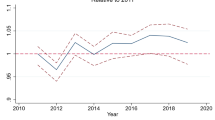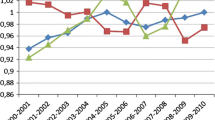Abstract
The objective of this article is to discuss the impact of healthcare financing systems on the efficiency of Mexican hospitals. The Mexican healthcare system is undergoing a process of transformation to establish conditions for allocating limited health resources in order to achieve efficiency and transparency; in this line, there is a concern about the implications of different funding options. In terms of financing arrangements, the Mexican health system is divided into three categories (one private and two public). In the framework of New Public Management theory, non-parametric metafrontier methods are used to estimate differences in efficiency of hospitals under different financing schemes, and in relation to the potential technology available in the healthcare system. Empirical evidence suggests that: 1) an out-of-pocket funding system, on average, incentivizes more efficient behavior; and 2) public funding seems to be the best option for complex and high-technology hospitals, and capitation appears to be the most appropriate way of negotiating their funding.




Similar content being viewed by others
Notes
In Mexico, decisions about investments and size of public hospitals are beyond the control of managers. For this reason, the efficiency of scale related to hospital size is not considered in our estimations.
Tableau Public software was used for visual analytics
R software was used to calculate the empirical results
References
Bannick RR, Ozcan YA (1995) Efficiency analysis of federally funded hospitals: comparison of DoD and VA hospitals using data envelopment analysis. Health Serv Manag Res 8(2):73–85
Ozcan YA, Luke RD, Haksever C (1992) Ownership and organizational performance: a comparison of technical efficiency across hospital types. Med Care 30(9):781–794
Leidl R (1998) Health care and its financing in the single European market. IOS Press, Amsterdam
Biorn E, Hagen T, Iversen T, Magnussen J (2003) The effect of activity-based financing on hospital efficiency: a panel data analysis of DEA efficiency scores 1992-2000. Health Care Manag Sci 6:271–283
Blank J, Eggink E (2014) The impact of policy on hospital productivity: a time series analysis of Dutch hospitals. Health Care Manag Sci 17:139–149
Hofmarcher M, Paterson I, Riedel M (2002) Measuring hospital efficiency in Austria —a DEA approach. Health Care Manag Sci 5:7–14
Lopez-Valcarcel B, Perez P (1996) Changes in the efficiency of Spanish public hospitals after the introduction of program-contracts. Investig Econ 20(3):377–402
Maniadakis N, Hollingsworth B, Thanassoulis E (1999) The impact of the internal market on hospital efficiency, productivity and service quality. Health Care Manag Sci 2:75–85
McCallion G, Glass J, Jackson R, Kerr C, McKillop D (2000) Investigating productivity change and hospital size: a nonparametric frontier approach. Appl Econ 32:161–174
Sommersguter-Reichmann M (2000) The impact of the Austrian hospital financing reform on hospital productivity: empirical evidence on efficiency and technology changes using a non-parametric input-based Malmquist approach. Health Care Manag Sci 3:309–332
Montenegro H, Levcovitz E, Holder R, Ruales J, Suárez J (2010) Redes Integradas de Servicios de Salud: Conceptos, Opciones de Política y Hoja de Ruta para su Implementación en las Américas, Serie 4 La renovación de la atención primaria de salud en las Américas, Organización Panamericana de la Salud
Vazquez M, Vargas I, Unger J, Mogollón A, Ferreira M, De Paepe P (2009) Integrated health care networks in Latin America: toward a conceptual framework for analysis. Rev Panam Salud Publica 26(4):360–267
Buchanan J (1986) Liberty, market and state: political economy in the 1980s. Harvester Press, Brighton
Williamson O (1981) The economics of organization: the transaction cost approach. Am J Sociol 87(3):548–577
Jensen M, Meckling W (1976) Theory of the firm: managerial behavior, agency costs, and ownership structure. J Financ Econ 3:305–360
Demsetz H (1967) Toward a theory of property rights. Am Econ Rev 57:347–359
Andrews R, Van de Walle S (2013) New public management and citizens' perceptions of local service efficiency, responsiveness, equity and effectiveness. Public Manag Rev 15(5):762–783
Mayston D (1999) The private finance initiative in the National Health Service: an unhealthy development in new public management? Financ Account Manag 15:249–274
Acerete B, Stafford A, Stapleton P (2012) New development: new global health care PPP developments—a critique of the success story. Public Money Manag 32(4):311–314
Alonso J, Clifton J, Díaz-Fuentes D (2015) The impact of new public management on efficiency: an analysis of Madrid's hospitals. Health Policy 119(3):333–340
Barlow J, Roehrich J, Wright S (2013) Europe sees mixed results from public–private partnerships for building and managing health care facilities and services. Health Aff 32:146–154
Pollitt C, Dan S (2013) Searching for impacts in performance-oriented management reform: a review of the European literature. Public Perform Manag Rev 37(1):7–32
Knaul M, Frenk J (2005) Health insurance in México: achieving universal coverage through structural reform. Health Aff 24(6):1467–1476
Frenk J (2006) Bridging the divide: global lessons from evidence-based health policy in México. Lancet 368(9539):954–961
Frenk J, González-Pier E, Gómez-Dantés O, Lezana M, Knaul F (2006) Comprehensive reform to improve health system performance in México. Lancet 368(9546):1524–1534
Knaul F, Arreola H, Méndez O, Miranda M (2006) Preventing impoverishment, promoting equity and protecting households from financial crisis: universal health insurance through institutional reform in Mexico. Fundación Mexicana para la Salud, Mexico
Du Gay P (2000) In Praise of Bureaucracy: Weber, Organization and Ethics. Sage, London
Jørgensen T (2011) Weber and Kafka. The Rational and the Enigmatic Bureaucracy. Public Adm 90(1):194–210
Langenbrunner J, Cashin C, O'Dougherty S (eds) (2009) Designing and implementing health care provider payment systems: how-to manuals. World Bank Publications
Niskanen W (1968) The peculiar economics of bureaucracy. Am Econ Rev 57(2):293–321
Weber M (1992) Economía y sociedad. Fondo de Cultura Económica, Buenos Aires
Dahl R, Tufte E (1974) Size and democracy. Politics of the smaller European democracies. Stanford University Press, Stanford
Ostrom V (1973) The intellectual crisis in American public administration. University Alabama Press, Tuscaloosa
Simonet D (2015) The new public management theory in the British health care system: a critical review. Adm Soc 47(7):802–826
Simonet D (2013) New public management and the reform of French public hospitals. J Public Aff 13(3):260–271
Anessi-Pessina E, Cantú E (2006) Whither managerialism in the Italian National Health Service? Int J Health Plann Manag 21:327–255
Correia T (2011) New public management in Portuguese health sector: a comprehensive reading. Sociología on Line 2:573–598
Donnan M, Katz G (2015) Choice in the American healthcare system: changing dynamics under the affordable care act. Curr Sociol Monogr 63(5):746–762
Mattei P (2006) The enterprise formula, new public management and the Italian health care system: remedy or contagion? Public Adm 84(4):1007–1027
Maynard A (1994) Can competition enhance efficiency in health care? Lessons from the reform of the U.K. National Health Service. Soc Sci Med 39(10):1433–1445
Moresi-Izzo S, Bankauskaite V, Gericke C (2010) The effect of market reforms and new public management mechanisms on the Swiss health care system. Int J Health Plann Manag 25:368–385
Ferrari A (2006) The internal market and hospital efficiency: a stochastic distance function approach. Appl Econ 38(18):2121–2130
Jakobsen M (2010) The effects of new public management: activity-based reimbursement and efficiency in the Scandinavian hospitals sectors. Scand Polit Stud 33(2):113–134
Cashin C, O’Dougherty S, Samyshkin Y, Katsaga A, Ibraimova A, Kutanov Y, Lyachshuk K, Olga Z (2005) Case-based hospital payment systems: a step-by-step guide for design and implementation in low- and middle-income countries. USAID Abt Associates Inc, Zdrav Reform Project
Kutzin J (2001) A descriptive framework for country-level analysis of health care financing arrangements. Health Policy 56(3):171–204
Maceira M (1998) Provider payment mechanisms in health care: incentives, outcomes and organizational impact in developing countries, major applied research 2, working paper 2. Partnerships for health reform project. Abt Associates Inc., Bethesda
Barnum H, Kutzin J, Saxenian H (1995) Incentives and provider payment methods. Int J Health Plann Manag 10(1):23–45
Joumard I, André C, Nicq C (2010) Health care systems: efficiency and institutions. OECD economics department working papers (769):1–133
Battese G, Rao D (2002) Technology gap, efficiency and a stochastic metafrontier function. Int J Bus Econ 1(2):87–93
Mitropoulus P, Talias M, Mitropoulus I (2015) Combining stochastic DEA with Bayesian analysis to obtain statistical properties of the efficiency scores: an application to Greek public hospitals. Eur J Oper Res 243:302–311
O’Donnell C, Rao D, Battese G (2008) Metafrontier frameworks for the study of firm-level efficiencies and technology ratios. Empir Econ 34:231–255
Asmild M (2015) Frontier differences and the Global Malmquist Index. In: Zhu J (ed) Data Envelopment Analysis. International Series in Operations Research & Management Science, vol 221. Springer, Boston
Färe R, Primont D (1995) Multi-output production and duality: theory and applications. Kluwer, Boston
Battese G, Rao D, O’Donnell C (2004) A metafrontier production function for estimation of technical efficiencies and technology gaps for firms operating under different technologies. J Prod Anal 21:91–103
Thiry B, Tulkens H (1992) Allowing for inefficiency in parametric estimation of production functions for urban transit firms. J Prod Anal 3(1-2):45–65.
Charnes A, Cooper W, Rhodes E (1978) Measuring the efficiency of decision making units. Eur J Oper Res 2(6):429–444
Ozcan YA (2014) Health care benchmarking and performance evaluation: an assessment using data envelopment analysis (DEA), 2nd edn. Springer, Newton
Banker R, Charnes A, Cooper W (1984) Some models for estimating technical and scale efficiencies in data envelopment analysis. Manag Sci 30(9):1078–1092
Asmild M, Hollingsworth B, Birch S (2013) The scale of hospital production in different settings: one size does not fit all. J Prod Anal 40:197–206
Hollingsworth B, Street A (2006) The market for efficiency analysis of health care organizations. Health Econ 15:1055–1059
Sodani P, Madnani G (2008) Measuring hospital performance through data envelopment analysis: understanding basic concepts to help novice researchers. J Health Manag 10(1):129–142
Jacobs R, Smith P, Street A (2006) Measuring efficiency in healthcare. Analytic techniques and health policy. Cambridge University Press
Simar L, Wilson PW (2002) Non-parametric tests of returns to scale. Eur J Oper Res 139(1):115–132
Instituto Nacional de Estadística y Geografía. Censo Poblacional 2010. [Online] Available at: http://www.censo2010.org.mx. Accessed 5 March 2016
Instituto Mexicano del Seguro Social. Datos abiertos 2015. [Online] Available at: http://datos.imss.gob.mx. Accessed 29 Aug 2015
Instituto de Seguridad y Servicios Social de los Trabajadores del Estado. Anuarios Estadísticos de la Dirección de Finanzas 2015. [Online] Available at: http://www2.issste.gob.mx:8080/index.php/mder-int-finanzas-anuarios. Accessed 29 Aug 2015
Instituto de Seguridad Social para las Fuerzas Armadas Mexicanas. [Online] Available at: https://datos.gob.mx/busca/organization/issfam. Accessed 8 March 2016
Dirección General de Información de Salud. [Online] Available at: https://www.gob.mx/salud/acciones-y-programas/direccion-general-de-informacion-en-salud-dgis. Accessed 20 March 2016
Instituto Nacional de Transparencia, Acceso a la Información y Protección de Datos Personales. Sistema INFORMEX Gobierno Federal 2015. [Online] Available at: https://www.infomex.org.mx. Accessed 5 Nov 2014
O’Neill L, Rauner M, Heidenberger K, Kraus M (2008) A cross-national comparison and taxonomy of DEA-based hospital efficiency studies. Socio Econ Plan Sci 42(3):158–189
Billor N, Hadi A, Velleman P (2000) BACON: blocked adaptive computationally efficient outlier nominators. Comput Stat Data Anal 34:279–298
Weber S (2018) Bacon: an effective way to detect outliers in multivariate data using stata (and Mata). Stata J: Promoting Communications on Statistics and Stata 10(3):331–338
Wilson P (1993) Detecting outliers in deterministic nonparametric frontier models with multiple outputs. J Bus Econ Stat 11:319–323
North DC (1990) Institutions, institutional change and economic performance. Cambridge University Press, New York
Cavagnero E, Bilger M (2010) Equity during an economic crisis: financing of the argentine health system. J Health Econ 29:479–488
Bertranou F (1999) Are market-oriented health insurance reforms possible in Latin America? The cases of Argentina, Chile and Colombia. Health Policy 47:19–36
Antonanzas F (2013) The impact of the economic downturn on healthcare in Spain: consequences and alternatives. Expert Rev Pharmacoecon Outcomes Res 13(4):433–439
Dahlgren G (2014) Why public health services? Experiences from profit-driven health care reforms in Sweden. Int J Health Serv 44(3):507–524
Zweifel P, Tai-Seale M (2009) An economic analysis of payment for health care services: the United States and Switzerland compared. Int J Health Care Finance Econ 9:197–210
O'Reilly J, Busse R, Häkkinen U, Or Z, Street A, Wiley M (2012) Paying for hospital care: the experience with implementing activity-based funding in five European countries. Health Econ Policy Law 7(1):73–101
Iriart C, Merhy EE, Waitzkin H (2001) Managed care in Latin America: the new common sense in health policy reform. Soc Sci Med 52(8):1243–1253
Wranik D (2012) Healthcare policy tools as determinants of health-system efficiency: evidence from the OECD. Health Econ Policy Law 7:197–226
Keith J, Prior D (2014) Scale and scope economies in Mexican private medical units. Salud Publica Mex 56(4):348–354
Acknowledgments
Víctor Giménez and Diego Prior acknowledge the financial support of the Spanish Ministerio de Economía y Competitividad (ECO2017-88241-R).
Author information
Authors and Affiliations
Corresponding author
Additional information
Publisher’s Note
Springer Nature remains neutral with regard to jurisdictional claims in published maps and institutional affiliations.
Rights and permissions
About this article
Cite this article
Giménez, V., Keith, J.R. & Prior, D. Do healthcare financing systems influence hospital efficiency? A metafrontier approach for the case of Mexico. Health Care Manag Sci 22, 549–559 (2019). https://doi.org/10.1007/s10729-019-9467-9
Received:
Accepted:
Published:
Issue Date:
DOI: https://doi.org/10.1007/s10729-019-9467-9




